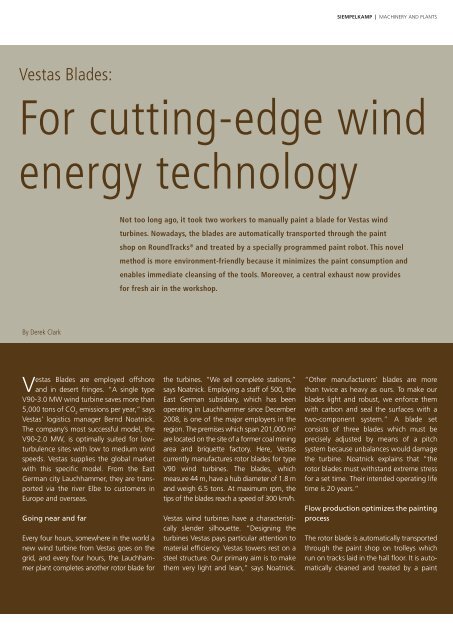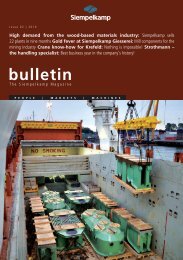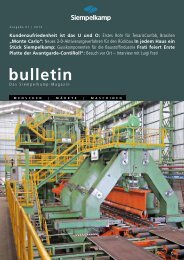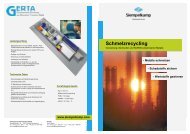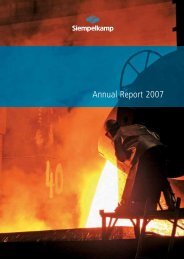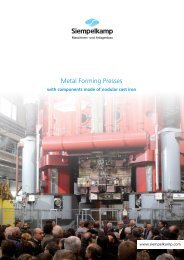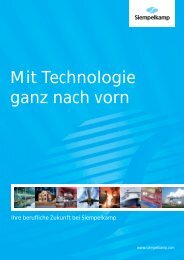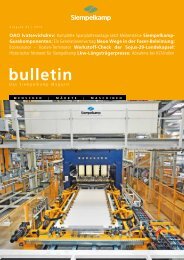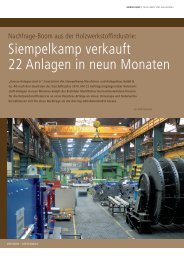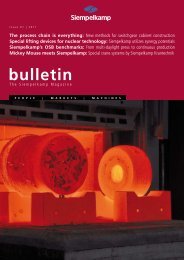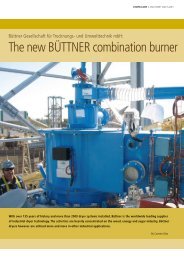Bulletin 1/2010 - Siempelkamp NIS
Bulletin 1/2010 - Siempelkamp NIS
Bulletin 1/2010 - Siempelkamp NIS
You also want an ePaper? Increase the reach of your titles
YUMPU automatically turns print PDFs into web optimized ePapers that Google loves.
Vestas Blades:<br />
By Derek Clark<br />
Vestas Blades are employed offshore<br />
and in desert fringes. “A single type<br />
V90-3.0 MW wind turbine saves more than<br />
5,000 tons of CO emissions per year,” says<br />
2<br />
Vestas’ logistics manager Bernd Noatnick.<br />
The company’s most successful model, the<br />
V90-2.0 MW, is optimally suited for lowturbulence<br />
sites with low to medium wind<br />
speeds. Vestas supplies the global market<br />
with this specifi c model. From the East<br />
German city Lauchhammer, they are transported<br />
via the river Elbe to customers in<br />
Europe and overseas.<br />
Going near and far<br />
Every four hours, somewhere in the world a<br />
new wind turbine from Vestas goes on the<br />
grid, and every four hours, the Lauchhammer<br />
plant completes another rotor blade for<br />
the turbines. “We sell complete stations,”<br />
says Noatnick. Employing a staff of 500, the<br />
East German subsidiary, which has been<br />
operating in Lauchhammer since December<br />
2008, is one of the major employers in the<br />
region. The premises which span 201,000 m²<br />
are located on the site of a former coal mining<br />
area and briquette factory. Here, Vestas<br />
currently manufactures rotor blades for type<br />
V90 wind turbines. The blades, which<br />
measure 44 m, have a hub diameter of 1.8 m<br />
and weigh 6.5 tons. At maximum rpm, the<br />
tips of the blades reach a speed of 300 km/h.<br />
Vestas wind turbines have a characteristically<br />
slender silhouette. “Designing the<br />
turbines Vestas pays particular attention to<br />
material effi ciency. Vestas towers rest on a<br />
steel structure. Our primary aim is to make<br />
them very light and lean,” says Noatnick.<br />
SIEMPELKAMP | MACHINERY AND PLANTS<br />
For cutting-edge wind<br />
energy technology<br />
Not too long ago, it took two workers to manually paint a blade for Vestas wind<br />
turbines. Nowadays, the blades are automatically transported through the paint<br />
shop on RoundTracks ® and treated by a specially programmed paint robot. This novel<br />
method is more environment-friendly because it minimizes the paint consumption and<br />
enables immediate cleansing of the tools. Moreover, a central exhaust now provides<br />
for fresh air in the workshop.<br />
“Other manufacturers’ blades are more<br />
than twice as heavy as ours. To make our<br />
blades light and robust, we enforce them<br />
with carbon and seal the surfaces with a<br />
two-component system.” A blade set<br />
consists of three blades which must be<br />
precisely adjusted by means of a pitch<br />
system because unbalances would damage<br />
the turbine. Noatnick explains that “the<br />
rotor blades must withstand extreme stress<br />
for a set time. Their intended operating life<br />
time is 20 years.”<br />
Flow production optimizes the painting<br />
process<br />
The rotor blade is automatically transported<br />
through the paint shop on trolleys which<br />
run on tracks laid in the hall fl oor. It is automatically<br />
cleaned and treated by a paint


